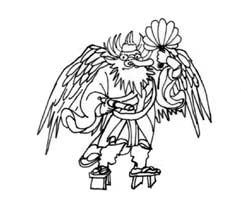|
||
 |
||

@
(C)2001 Japanese Architecture and Art Net Users System.@No reproduction or republication without written permission.
fΪΜeLXgEΚ^ECXgΘΗASΔΜRecΜ³f‘»E]ΪπΦΆά·B
|
||||||
| @ | ||||||
| tengu@Vη | ||||||
| KEY WORD :@art history / paintings | ||||||
| @ | ||||||
| Lit. celestial dog. A bird-like goblin frequently encountered in Japanese folk-beliefs, literature and their pictorial depictions. The Japanese demons derive the name from the Chinese mountain god Tiangou (Jp: Tengu Vη), but also are related to the winged Buddhist deity Garuda. Furthermore, tengu are seen as transformations keshin »g of Shinto deities yama-no-kami RΜ_, mountain guardians often associated with tall trees. Tengu are of two physical types; karasutengu GVη identified by a bird's head and beak, and konoha tengu ΨΜtVη distinguished by a human physique but with wings and a long nose. This type of tengu often carries a feather fan in one hand. Because of its long nose, tengu are associated with the Shinto deity Sarutahiko cF who takes on the visage of a monkey, and tengu masks play a prominent role in some religious festivals. Early Japanese popular tales such as those in the KONJAKU MONOGATARI ‘Μ¨κ (early 12c) portray tengu as enemies of Buddhism, setting fires at temples or tricking priests. Priests who attain special powers through religious discipline, but use these powers for their own ends were thought to enter in the next life the transmigratory realm of tengudou VηΉ. The earliest representations of tengu are in Kamakura period *emaki Gͺ, such as the Tengu zoushi emaki VηGͺ (1296), Nezu ͺΓ Museum, Tokyo, which criticize arrogant priests who end up becoming tengu. According to legend, as a boy the famous warrior Minamoto no *Yoshitsune Ή`o (1159-89) trained in magical swordsmanship with the tengu king Soujoubou m³V near Kuramadera Ζn in the mountains north of Kyoto. Tengu frequently are shown in pictures concerning the life of Yoshitsune, including both the Hogen-Heiji Ϋ³½‘ battle screens, Metropolitan Museum NY, and depictions of Hashi Benkei ΄Ωc (*Benkei Ωc at the Bridge) theme. The Momoyama period daimyo εΌ Kobayakawa Takakage ¬μ²i (1533-97) supposedly held dialogues with the tengu king Buzenbou LOV on Mt. Hiko F. The character of tengu gradually changed over the centuries. For instance, tengu were long thought to abduct children, but by the Edo period they often were enlisted to aid in the search for missing children. Similarly, tengu became temple guardians and sculpted images of them were placed on or around temple buildings. Tengu also are associated with yamabushi R (mountain ascetics), whose form they often assumed. Tengu often are depicted wearing the yamabushi's distinctive cap and robe. Illustration of tengu increased in popularity and variety during the Edo period, usually reflecting the more positive and even light-hearted conception of the once-ferocious demon. In particular, the long nose of the tengu carried both comic and sexual meaning in *ukiyo-e ’G prints. | ||||||
| @ | ||||||
 |
||||||
@ |
||||||
| REFERENCES: | ||||||
| @ | ||||||
| EXTERNAL LINKS: | ||||||
| @@ | ||||||
| NOTES: | ||||||
| @ | ||||||
(C)2001 Japanese Architecture and Art Net Users System.@No reproduction or republication without written permission. fΪΜeLXgEΚ^ECXgΘΗASΔΜRecΜ³f‘»E]ΪπΦΆά·B |
||||||
| @ |